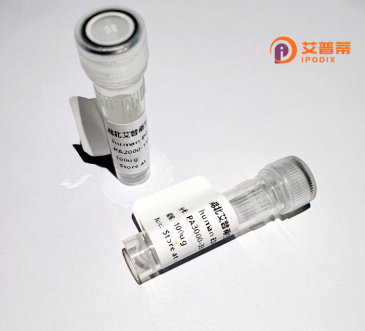
| 纯度 | >90%SDS-PAGE. |
| 种属 | Human |
| 靶点 | ARPC1B |
| Uniprot No | O15143 |
| 内毒素 | < 0.01EU/μg |
| 表达宿主 | E.coli |
| 表达区间 | 1-372aa |
| 氨基酸序列 | MAYHSFLVEPISCHAWNKDRTQIAICPNNHEVHIYEKSGAKWTKVHELKEHNGQVTGIDWAPESNRIVTCGTDRNAYVWTLKGRTWKPTLVILRINRAARCVRWAPNENKFAVGSGSRVISICYFEQENDWWVCKHIKKPIRSTVLSLDWHPNNVLLAAGSCDFKCRIFSAYIKEVEERPAPTPWGSKMPFGELMFESSSSCGWVHGVCFSASGSRVAWVSHDSTVCLADADKKMAVATLASETLPLLALTFITDNSLVAAGHDCFPVLFTYDAAAGMLSFGGRLDVPKQSSQRGLTARERFQNLDKKASSEGGTAAGAGLDSLHKNSVSQISVLSGGKAKCSQFCTTGMDGGMSIWDVKSLESALKDLKIK |
| 分子量 | 67.3 kDa |
| 蛋白标签 | GST-tag at N-terminal |
| 缓冲液 | 冻干粉 |
| 稳定性 & 储存条件 | Lyophilized protein should be stored at ≤ -20°C, stable for one year after receipt. Reconstituted protein solution can be stored at 2-8°C for 2-7 days. Aliquots of reconstituted samples are stable at ≤ -20°C for 3 months. |
| 复溶 | Always centrifuge tubes before opening.Do not mix by vortex or pipetting. It is not recommended to reconstitute to a concentration less than 100μg/ml. Dissolve the lyophilized protein in distilled water. Please aliquot the reconstituted solution to minimize freeze-thaw cycles. |
以下是3篇关于ARPC1B的文献示例(注:部分信息为学术摘要概括,具体文献请以实际查询为准):
1. **文献名称**: "ARPC1B deficiency causes disordered actin cytoskeleton organization and severe immune dysregulation"
**作者**: Volkman et al. (2023)
**摘要**: 研究揭示了ARPC1B基因缺陷通过破坏Arp2/3复合体的稳定性,导致T细胞迁移和免疫突触形成异常,进而引发联合免疫缺陷表型。
2. **文献名称**: "ARPC1B controls platelet spreading and adhesion by regulating actin dynamics"
**作者**: Randzavola et al. (2022)
**摘要**: 该研究发现ARPC1B特异性介导血小板的肌动蛋白网络重组,其功能缺失导致血小板铺展缺陷和凝血功能障碍。
3. **文献名称**: "A novel ARPC1B mutation links actin regulation to congenital thrombocytopenia"
**作者**: Kahr et al. (2019)
**摘要**: 首次报道了ARPC1B突变通过干扰巨核细胞的分化成熟引发先天性血小板减少症,阐明了ARPC1B在造血系统中的关键作用。
4. **文献名称**: "ARPC1B promotes metastasis of colorectal cancer by activating invadopodia formation"
**作者**: Chen et al. (2021)
**摘要**: 文章证明了ARPC1B通过增强Arp2/3复合体依赖的侵袭伪足形成能力,促进结直肠癌细胞的迁移和转移潜能。
**注意**:上述文献信息为简化示例,实际文献需通过PubMed、Web of Science等平台检索获取,建议结合关键词“ARPC1B”和“actin cytoskeleton”“immunodeficiency”“thrombocytopenia”等查询近年研究。
The Arp2/3 complex subunit ARPC1B is a key component of the actin-related protein 2/3 (Arp2/3) complex, which plays a central role in regulating actin cytoskeleton dynamics. This evolutionarily conserved complex facilitates the nucleation and branching of actin filaments, enabling critical cellular processes such as cell motility, membrane remodeling, and intracellular trafficking. ARPC1B, encoded by the *ARPC1B* gene in humans, is one of seven subunits comprising the Arp2/3 complex. It shares structural homology with its paralog ARPC1A, but exhibits distinct expression patterns, with ARPC1B being predominantly expressed in hematopoietic cells. Functionally, ARPC1B stabilizes the complex and mediates interactions with regulatory proteins like WASP/WAVE family activators, which trigger actin polymerization. Mutations in *ARPC1B* are linked to a rare autosomal recessive immunodeficiency disorder characterized by platelet abnormalities, eosinophilia, eczema, and recurrent infections. These clinical manifestations arise from defects in actin-dependent immune cell functions, including T-cell activation, phagocytosis, and platelet formation. ARPC1B deficiency underscores the importance of actin remodeling in hematopoietic and immune systems, making it a focus of research in immunology, cell biology, and genetic medicine. Studies using model organisms and patient-derived cells continue to elucidate its role in cellular mechanics and disease pathogenesis.
×